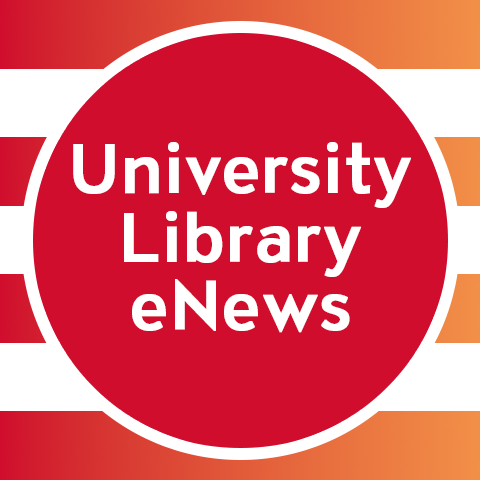Newsletter Edition: Fall 2023
Contributed by Mark Stover and Kathy Dabbour
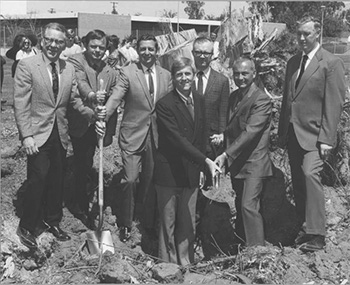
As the calendar marks another year, the CSUN University Library (formerly known as the Oviatt Library) approaches a historic milestone—the 50th anniversary of its opening on October 24, 1973. From its inception to its current status as a dynamic hub for learning, innovation, and collaboration, the University Library has seen significant transformations, triumphs, and challenges. This retrospective provides a lens into the Library's rich history and architectural growth, its recovery from natural disasters, and its continuous innovation over the last half-century.
Land Acknowledgement
California State University, Northridge (CSUN) proudly recognizes and acknowledges the Sesevitam, the first people of this ancestral and unceded territory of Sesevenga, which is now occupied by the University. It honors their elders, past and present, and the Sesevitam descendants, who are citizens of the Fernandeño Tataviam Band of Mission Indians. We recognize that the Sesevitam are still here, and we are committed to lifting up their stories, culture, and community.
The Backstory: 1956-1971
On September 24, 1956, the then-San Fernando Valley satellite campus of Los Angeles State College of Applied Arts and Sciences (now California State University, Los Angeles) held its first classes, and Library service began in bungalow "J," located next to what would become the Student Union on Lindley Ave. Between 1957 and 1958, the growing Library needed to rent a former meat market on Reseda Blvd and use a hayloft in a stable at Devonshire Downs for storage. On July 1, 1958 the SFV satellite campus became San Fernando Valley State College (SFVSC).
On March 3, 1959, the San Fernando Valley State College Library, the first permanent building on campus, opened with 75,000 volumes and services located on the first two floors of the four-story building, and by 1967, the Library occupied all four floors of the building.
The Birth of a Vision: 1970s
The roots of the CSUN University Library building can be traced back to May 19, 1971, when the groundbreaking ceremony was held. It was initially named the Delmar T. Oviatt Library, after the prominent CSUN figure. Architect Leo A. Daly was commissioned for the project, with a budget of $7.5 million. In 1972, San Fernando Valley State College became California State University, Northridge (CSUN). By October 24, 1973, the date we now celebrate as the 50th Anniversary of the University Library, the first phase was completed and the Oviatt Library opened, boasting 137,896 net square feet and a seating capacity of 1,674.
The old Library (called South Library) remained in operation but housed only the Science collection and services, University Archives, Urban Archives, the Instructional Materials Laboratory, and Technical Services, and continued as such until the opening of the Oviatt Library’s wings.
Expansion and Upgrades: The Early 1990s
By 1991, the second phase of the University Library—the addition of wings on the east and west side of the main building was completed, again under the supervision of Leo A. Daly and with Kiewit Construction as the contractor. This extension cost $18.4 million, bringing the total square footage to 234,712.
With the addition of the wings, the CSUN University Library became home to an innovative Automated Storage and Retrieval System (AS/RS), the first of its kind for libraries. Built in 1991 at a cost of $2 million, the AS/RS consists of 13,260 steel bins of varying heights, organized in a rack structure that spans 8,000 square feet and stands 40 feet high. These bins are located in six aisles, each of which has a Storage and Retrieval Machine (SRM) or robotic crane to facilitate item retrieval. The AS/RS continues to be a popular destination for tour groups from both the local area and international, and the AS/RS Viewing Room, from which one can often see the robotic cranes zipping toward their targeted bin, is a popular place to study.
The system can store an estimated 1.2 million items, sorted by height and type, and is currently at 67% of its capacity. Items in the AS/RS can be requested via the Library OneSearch tool, and the requested materials are usually available for pickup at the Guest Services Desk in less than ten minutes.
Although the AS/RS was initially equipped with software developed in the late '80s and early '90s, it has undergone three major upgrades since its inception. These upgrades, completed in 2011, 2019, and 2021, focused on improving the SRMs' controllers, communications, positioning, and safety infrastructure.
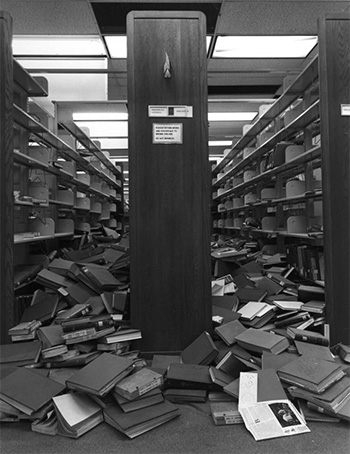
The Earthquake and Recovery: 1994-2000
On January 17, 1994, a devastating 6.8 magnitude earthquake struck Northridge, severely damaging the Library, and forcing its closure. During the earthquake, 90 percent of the open-shelf collection fell onto the floor and the original Library building, known as the “core” was substantially damaged and was closed indefinitely. But as adversity often reveals character, partial services almost immediately resumed in trailers parked next to the Library, and then CSUN President Blenda Wilson prioritized its reconstruction, recognizing the library’s significance as an integral campus structure. By spring, 1994, three temporary buildings containing 31,000 square feet of library space opened up at a cost of almost $2.5 million dollars to house Library Technical Services, specialized collections and services, and study spaces that had formally been in the recently built east and west wings.
By the fall of 1994, the Library’s core was restored at a cost of $11 million and services were restored, but the wings, which were beyond repair, remained closed, and had to be partially torn down in the summer of 1997. By July 1998, reconstruction of the wings began at a cost of $22 million, and by July 2000, the Library completed its move back into the newly rebuilt wings. At the same time, the Library was approved to build a grand staircase at the south end of the portico and add terracing to the lawn, both of which added to the iconic architecture of the University Library, which continued to be a location of several commercial films and campus publicity campaigns. On September 26, 2000, the rededication of the Oviatt Library and re-opening of the wings ceremony was held.
Transforming Library: 2012-2023
The Learning Commons
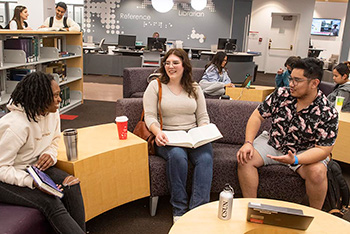
Completed in the summer of 2013, the first-floor Learning Commons was the first major renovation of the Library since the wings re-opened in fall 2000, and it is a cornerstone of the Library’s plan to encourage academic success by combining critical research and technology services to support coursework, scholarship, and co-curricular enrichment in a welcoming, collaborative environment with modern furnishings and technology. The Information Technology Service Desk assists students, faculty, staff, and visitors with accessing the campus network and other resources. As part of the Learning Commons renovation, a new, permanent Freudian Sip coffee shop was built in the lobby, offering Starbucks® drinks, and pastries and other food items, which can be enjoyed almost anywhere in the Library.
The fall of 2013 saw the move of the campus Learning Resource Center (LRC) into the University Library, now situated on the third floor, East Wing. The LRC offers workshops, one-on-one and group tutoring, and supplemental instruction classes to help CSUN students develop effective study strategies, improve writing skills, and excel in subject-matter courses. Through its mission and services, the LRC joins the University Library in a strategic partnership and commitment to fostering an environment of academic excellence and lifelong learning.
Library Technology Services & Creative Maker Studio
Among its many services, the Library Technology Services desk helps with free self-service scanning, student lab printing, desktop computers, and loans out laptops, tablets, hotspots, and related devices and other technical accessories. Beginning in fall 2023, the LTS took over CSUN IT’s Device Loaner Program to checkout laptops/tablets, Internet hotspots, and webcams to CSUN students who are lacking these critical resources at home.
The Creative Maker Studio (CMS), built in 2014 thanks to Campus Quality Fee funding, is an exploratory space where students of any major can have access to hands-on multimedia design and production tools for learning new technologies, prototyping, collaboration, and digital creation/modeling/editing at no additional cost. Also, paid for out of CQF funding, the CMS has 3D printers, sewing machines, audio recording and video production studios, crafting equipment, 3D scanning, and a virtual reality room, offers access to software for engineering and film/audio projects, and loans out multimedia devices. Available to current CSUN students only, the CMS can be used for coursework or leisure, or career exploration of makerspace equipment and services.

Robert and Maureen Gohstand Leisure Reading Room
The Robert and Maureen Gohstand Leisure Reading Room, located on the West Wing's second floor, was refurbished in fall 2013 to offer a dedicated space for leisure reading. A haven for those looking to escape academic rigors, this room, formally dedicated in October 2014, continues to develop its collection for the comfort and benefit of readers.
Special Collections & Archives
January 2018 marked the grand reopening of the Special Collections and Archives, after two years of renovations funded by private donors. The newly expanded department provides twice the space for its unique collection of 50,000 cataloged items, housed in a temperature and humidity-controlled high-density storage facility. The remodel includes a wood-paneled Reading Room with floor-to-ceiling windows, offering an inviting space for research.
In 2020, also funded by private donors, the Library Exhibit Gallery’s beautiful but difficult to maintain green and rust cork flooring was upgraded to easy to maintain Luxury Vinyl Tile (LVT) flooring in a light maple shade that creates a bright, airy, and modern environment for Special Collections & Archives exhibits.
Teacher Curriculum Center/Music & Media Merger
The summer of 2018 saw the renovation of the Music & Media department to accommodate the Teacher Curriculum Center. The newly combined department, known as Teacher Curriculum Center/Music & Media (TCC/M&M), is a dynamic and comfortably furnished environment catering to a wide array of academic needs. The collections support K-12 teaching and learning, including curricular materials, manipulatives and games, and children’s books; and music books, scores, and physical sound recordings, and physical audiovisual media, which compliments the Library’s extensive collection of instructional media databases.
Room 26 and the Map Collection
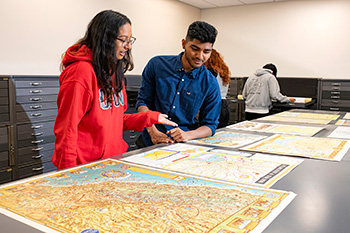
Another notable renovation occurred between 2018-2019 when Room 26 on the Garden Level was redesigned to house the University Library Map Collection, accessible from the northeast stairwell or the Learning Commons' East Wing elevator. The University Library Map Collection contains over 400,000 historical and government maps, aerial photographs, and atlases that mostly focus on Western Americana, but include other states and international maps, too. Additionally, the Map Collection provides computers for accessing geospatial data that support student and faculty research on campus and outside researchers.
Other Collections Added to the University Library
Established in 1978, the NCOD Resource Center initially served as a standalone repository at CSUN for one of the nation's largest collections of deaf-related materials, including books, journals, dissertations, videotapes, DVDs, CDs, and documents. Often referred to as the "Deaf Library" by students, faculty, and community members both within and outside the CSUN campus, the center has been a pivotal resource. In 2016, the NCOD Resource Center underwent a significant transition when its collections and staff were integrated into the CSUN University Library. This move not only ensured the preservation of these invaluable resources but also expanded access to a broader audience, leveraging the University Library's infrastructure to better serve the needs of those interested in deaf education and research.
Along with the NCOD Library, other significant collections have been integrated into the University Library over the past 25 years, including the Tom and Ethel Bradley Center Archives; the International Guitar Research Archive (IGRA); the Old China Hands Archive; the Harry Stone Charles Dickens Collection; the Sharon Fogarty Young Readers' Collection; and the Karin J. Duran Teacher Curriculum Center Collection. The addition of these important book and archival collections to the CSUN University Library over the past three decades significantly enriches the educational experience for students, faculty, and the broader community. These collections serve as invaluable reservoirs of knowledge and research, offering diverse perspectives across various fields and disciplines. For students, they provide essential resources for academic exploration and scholarly work. Faculty members benefit from enhanced research opportunities, while the community gains access to a wide array of informational and cultural assets that promote lifelong learning and civic engagement. Overall, these collections elevate the intellectual and cultural vitality of the university and its surrounding community.
Infrastructure and Furniture Upgrades
Recognizing the need for improved accessibility, the Library modernized its elevators in the core facility, a project completed in the spring of 2016. This overhaul not only replaced mechanical systems and cabling but also refurbished the interior of the elevator cabins.
With over 10,000 fluorescent interior lightbulbs, each drawing around twenty-five watts of power, and a number of other high-wattage bulbs around the library’s exterior, by the end of 2020 the University Library’s lighting was upgraded with LED alternatives, representing significant electricity savings and lowering greenhouse gas emissions for CSUN each year.
From 2021 to 2023, the Library’s south portico and hardscaping underwent major renovations due to perennial rain water leaks into the interior of some areas of the garden level and other critical upgrades. After many months of being surrounded by construction fencing and equipment, the portico emerged with upgraded tiles that complement the original bricks, which are still located on the east, west, and north sides of the Library.
As part of the second phase of creating a welcoming and collaborative study environment like the Learning Commons, in 2022, the Library finished upgrading the carpeting and study furniture on the second floor core to encourage a collaborative and welcoming environment that complements the main floor Learning Commons. In the interest of supporting individual study, the fourth floor east wing was renamed the Quiet Study Lounge, and old study tables and seating are in the process of being replaced with semi-private study “pods” that are equipped with comfortable seating for one and built-in power to meet the needs of students who need a quiet, distraction-free environment for studying and using their laptops and other devices.
A New Chapter: The Name Change
In December 2020, the Library was renamed from Delmar T. Oviatt Library to University Library, following recommendations outlined in the Report of the Oviatt Library Advisory Working Group (PDF). The change was approved by multiple governing bodies, signifying a new era for this central institution.
Vast Collections and Services
Today, the CSUN University Library continues to play a multi-dimensional role in the university. Apart from supporting traditional academic pursuits through its large collection of approximately 2 million book titles, 200,000 journal and serial titles, and 100,000 media titles, in physical and electronic formats, the Library provides a rich array of resources, including over 250 premier subscription databases, specialized collections, and archival resources in physical and digitized formats to support and facilitate classroom and independent learning, student and faculty research, and community and cultural engagement.
In 2021/22, usage of all physical and electronic collections totaled about 2 million checkouts. Despite being open less hours for part of the year or with most students attending at least some of their classes online, the Library still had over 300,000 entries to the building and 2.8 million webpage views, provided instruction sessions to over 17,000 students, and answered 4,700 questions. As CSUN and the University Library continue to recover from the pandemic, these numbers are expected to grow.
The Road Ahead
As the CSUN University Library looks forward to the next 50 years, we carry the legacy of resilience, innovation, and academic excellence. With each renovation, upgrade, and community endeavor, we renew our commitment to serving the ever-changing needs of our diverse patron base. The retrospective journey from our modest beginnings in 1973 to the multifaceted institution today gives us a moment to celebrate, reflect, and anticipate the ongoing saga of this vital academic resource.
